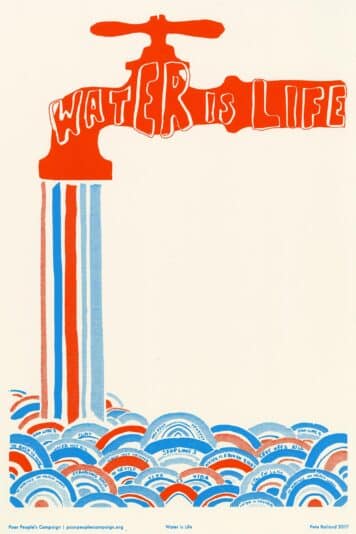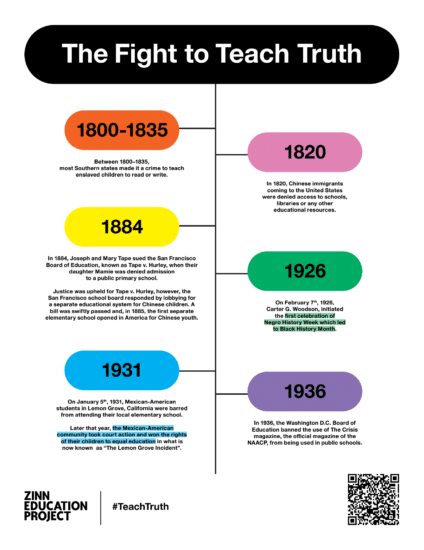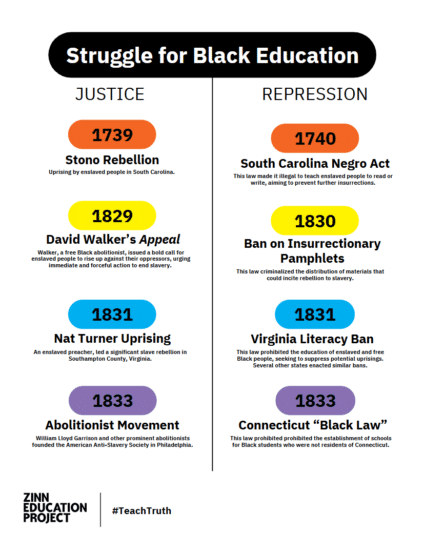
Mini-lessons serve as an affirmation that we defy censorship by teaching “banned history” in a public space. You can make visible the history we are defending the right to teach. Participants benefit from becoming informed about key issues and inspired to take action.
We offer a range of downloadable resources and procedures. The content options, that can be used as gallery walks or mixers, are:
- Key Issues in Race and Education Timeline
- Struggle for Black Education Timeline
- Struggle for Black Education: Quotes
- Resistance 101
- Water and Environmental Racism
Each activity helps participants explore issues in the history of the struggle for justice in education and make connections to today. Let us know if you use or adapt these.
Procedure
Step 1: Choose the Content for Your Activity
Choose one or a combination.
Key Issues in Race and Education TimelineThis timeline highlights key moments in the history of race and education dating from the colonial era to today. The events in the visual display are drawn from a more detailed timeline at the Civil Rights Teaching website. The events include the struggle for free education for people of all races and Native Americans. It also includes the history of repression, such as the Native American boarding schools, the Mississippi Black Codes, segregation of Asian American students, burning of Black schools during Reconstruction, legal cases such as Brown v. Board and Mendez v. Westminster, and more. Engaging with the timeline makes clear that the fight for quality education has been a constant struggle throughout U.S. history. Download: Single entry per page or Multiple entries per page |
|
Struggle for Black Education TimelineThis timeline explores the long history of the struggle for Black education. This activity reveals a pattern: When Black people make significant educational gains — or score victories in their broader struggles for freedom — there is a corresponding white supremacist backlash that often includes legal restrictions and violence. Education provides the knowledge and critical thinking skills necessary to challenge racist systems and envision a future free from oppression. Consequently, movements for Black liberation and racial justice have frequently included demands for education, such as the expansion of Black Studies and Ethnic Studies programs, as well as the removal of institutional racism in schools. Engaging with this timeline helps participants recognize patterns of how people have bravely fought for racial justice and Black educational justice and how it has often been met with resistance and suppression. Download: Timeline: Justice vs. Repression |
|
Struggle for Black Education: QuotesHere are quotes by noted scholars and activists including W. E. B. Du Bois, Mary McLeod Bethune, Septima Clark, Malcolm X, and more on the importance and struggle for education. These are from the lesson by Jesse Hagopian, Legalize Black Education: The Battle Against Black Education Suppression Laws. Download: Quotes: Struggle for Black Education |
 |
Resistance 101This lesson allows participants to “meet” people from throughout U.S. history who have resisted injustice and to learn from the range of strategies they have used. It is designed as a mixer, but the profiles could also be posted for a gallery walk. Download: Resistance 101 Note: You will need to sign up in order to download the lesson plan. |
 |
Water and Environmental RacismThis lesson allows participants to learn about the struggle of residents to access safe water for drinking, cooking, and bathing in the majority-Black cities of Flint, Michigan; Jackson, Mississippi; and Newark, Download: Water and Environmental Racism Note: You will need to sign up in order to download the lesson plan. |
 |
Step 2: Choose the Type of Activity
We suggest doing either a Gallery Walk or a Mixer activity.
The traditional gallery walk is created with readings or images arranged around a room, taped to walls at eye level. The content is spaced out so participants can walk freely between them.
If conducting the activity in a space that does not permit taping on the walls — or outside with no walls — volunteers can hold the materials (quotes, timeline entries, or profiles) for people to see as they walk around. (People can switch roles from readers to those holding the materials so everyone gets a chance to circulate and read.)
For a mixer, everyone gets a copy of one of the profiles and a set of interview questions. They read their role (or document) and then go around and interview each other in pairs.
Step 3: Prepare the Materials
Make copies of the content you selected in step one. If you are using the Resistance 101 mixer lesson, make sure each of the roles are on a separate sheet of paper and print a copy of the questions for each participant.
Gather sticky notes, post-its, and pens for participants.
Step 4: Set Up the Space
If doing a gallery walk, tape the quotes or timeline excerpts around the room. We recommend using painters tape. Leave blank pages so participants can add their own quotes to the collection of quotes, or add what action they plan to take to support teachers and librarians at the end of the timeline.
If doing a mixer, create open space for participants to move unrestricted. If you’ll have chairs, we recommend arranging them in a circle.
Consider playing music softly — especially music that has been part of the Black freedom struggle — to create an engaging atmosphere.
Step 5: Launch the Activity
Welcome Participants & Introduce the Activity
-
-
- For the Black education quotes or timeline: We will explore how education has been central to Black liberation — and how it has been challenged and resisted.
- For the Race and Education timeline: We will explore how the fight for the freedom learn has been a constant struggle for all people of color, Native Americans, and poor whites throughout U.S. history.
- For the Resistance 101 mixer: We’ll learn a range of resistance strategies from activities from throughout U.S. history.
- For the Water and Environmental Racism: We’ll learn about the struggle of residents to access safe water for drinking, cooking, and bathing in the majority-Black cities of Flint, Michigan; Jackson, Mississippi; and Newark, New Jersey.
-
Provide the Materials
Gallery Walk
-
-
- Hand out post it notes and pens.
- Point to the quotes, timeline, or profile around the room.
- If there are no walls or vertical space, hand out quotes, timeline dates, or mixer roles (and questions) for participants to hold up for folks to read.
-
Mixer
-
-
- Hand out quotes, timeline dates, or mixer roles (and questions). For the latter, also pass out a pen.
-
Explain the Process
Gallery Walk
Say to participants:
-
-
- Each of you stand near a different quote or timeline entry so that you are spaced apart around the room.
- Using sticky notes, respond with your reactions, questions, or connections. Note that for the Black education quotes, some have tension between them, while others support each other. Think about what they say separately and together, which ones you agree with most, and which you may think are less useful.
- Circulate the room, reading and responding to as many quotes or timeline entries as time allows. We’ll begin silently so everyone has a chance to read and write, and then open it up for conversation.
- Build on each other’s comments, writing responses to the notes left by others and engaging with as many quotes as possible.
-
Mixer
Say to participants:
-
-
- Read the role you were provided.
- If sticky name tags are available, make a name tag for yourself with your role.
- Underline any key points you think are particularly important.
- Look at the question sheet and consider what your responses will be.
- Now, move around the room and talk with one person at a time to find the answers to the questions on your sheet.
- Don’t show your profile sheet, instead use the information to answer the questions yourself in the conversation. You can speak in first or third person.
-
Interaction
-
-
- Allow about 20 minutes for the gallery walk or mixer activity.
- The facilitators can participate, too, and be ready to help if people have questions about the process.
- Take photos (with permission) of people engaging in the mixer or gallery walk and of the sticky notes and share them as part of a public education campaign. You can post them to social media with #TeachTruth and tag @ZinnEdProject.
-
Small Group Discussions
Here are suggested discussion questions for the respective content. Invite people to discuss the questions in small groups.
Fight to Teach Truth Timeline
-
-
- Why do you think those in power have tried to control what is taught or read in schools?
- What are the consequences of denying people access to their own histories and identities?
- How do you think access to education shapes someone’s opportunities in life?
- Why do you think some people are uncomfortable with diversity-focused education like Ethnic Studies or LGBTQ+ literature?
-
Black Education Timeline
-
-
- How do early anti-literacy laws for enslaved people connect to today’s efforts to ban books and limit curriculum on systemic racism?
- What patterns do you notice in how laws restricting Black education have evolved over time?
- Who benefits from limiting access to knowledge and who is harmed?
- What lessons can we learn from past struggles for Black education that we can apply today?
- How can community groups, educators, parents, and students organize to protect the right to learn?
-
Black Education Quotes
-
-
- Which quote did you like the best and why?
- Were there any quotes you disagreed with and why?
- Which quote might be useful to communicate with people in your community about the importance of defending the freedom to learn?
-
Resistance 101
-
-
- What new approaches to organizing did you learn about?
- Which approaches might be useful for contemporary issues in your community?
-
Water and Environmental Racism
-
-
- What are the similarities between the Flint, Jackson, and Newark examples? What differences did you notice?
- How do the stories in this activity illustrate “environmental racism”?
- What caused these crises? Who or what is to blame?
-
Step 6: Closing & Action Steps
Whole Group Discussion
Here are suggested whole group discussion questions for the respective content.
Timelines
-
-
- Ask volunteers to share significant events from the timeline that they found impactful.
- Encourage participants to share what they heard from the group members or what they wrote down to answer the questions.
- Discuss how the historical restrictions on Black education have evolved over time and how these struggles persist today.
-
Connecting to Today’s Struggles
-
- Remind participants that attacks on truthful education — like banning Black Studies, censoring discussions on race, and restricting books — are part of a long history.
- Ask: How do we see this playing out today? How have those in the past fought back? What can we do to fight back?
Encourage Action
Provide suggestions, such as:
-
-
- Defending and expanding Ethnic Studies and Black Studies programs.
- Speaking out against book bans and curriculum restrictions.
- Attending school board meetings to advocate for truthful education.
- Organizing Teach Truth events and public reading circles.
- Participating in direct action campaigns at our statehouse against laws that ban honest curriculum about race, gender, and sexuality.
- Sign a local petition and/or national petition.
-
Final Reflection
-
-
- Have participants share one insight they are taking away.
- End with a call to action: How will you carry this conversation forward?
-











Twitter
Google plus
LinkedIn